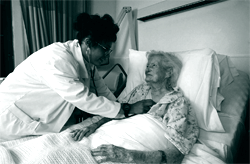September 2009
In this Issue
Flexibility in Combating Homelessness
Development Regulations: How Do They Affect the Local Labor Supply?
Mortgage Insurance Facilitates Affordable Financing
HUD Field Economists Keep Tabs on U.S. Housing Markets
In the next issue of ResearchWorks
Mortgage Insurance Facilitates Affordable Financing
Many hospitals and long-term care facilities are finding that access to the funds needed to perform required improvements is limited in the private credit market. However, other options are available from HUD through the Federal Housing Administration (FHA). In support of its mission to promote community development, HUD offers mortgage insurance programs for these facilities. One program provides hospitals with access to financing, while the other does so for long-term care facilities.
Sections 232 and 242 are mortgage insurance programs under the National Housing Act that keep the financing of health care and long-term care facilities affordable. Section 232 is an FHA-insured loan product that, since 1934, has backed mortgages for facilities that provide long-term care. Nursing homes, assisted living facilities, and "board and care" facilities can all be insured under this program, which insures mortgage loans that finance the purchase, refinance, new construction, and substantial rehabilitation of such developments, as well as the installation of fire safety equipment. Section 242, a similar FHA-insured loan product that has been available since 1968, facilitates the financing of hospitals for the care and treatment of persons who are acutely ill or who otherwise require medical services typically available from hospitals. Like the 232 program, these insured loans can be used for new construction, purchase, rehabilitation, refinancing, and installing fire safety equipment.

The 232 and 242 programs afford an array of benefits to qualifying facilities. These mortgage insurance programs provide AA and AAA credit ratings, which result in lower interest rates, and government backing improves the creditworthiness of organizations securing the loans. Fixed-rate loans with repayment periods of up to 25 years (Section 242) or 40 years (Section 232) are also offered. There is no maximum loan amount for hospital applicants (Section 242), and the loan-to-value ratio can be up to 90 percent. In addition, a limited amount of cash is required at closing (with none required when sufficient equity exists) and 99 percent of the loan amount is insured by FHA.
For assisted living, board and care, and nursing home facility applicants (Section 232), the maximum amount of a loan for both new and existing projects is 85 percent (90 percent for nonprofit sponsors) of the estimated value of physical improvements and major movable equipment, such as hospital beds, wheeled equipment, and office furniture.

In the 75 years since the Section 232 mortgage insurance program’s inception, the program has issued 4,000 insured loans totaling $16 billion to both nonprofit and for-profit organizations in all 50 states. One such applicant is Wilmac Corporation, a for-profit, family-owned senior health care provider in Pennsylvania. With the assistance of Lancaster Pollard, an underwriter that serves the health and long-term care sectors, Wilmac Corporation used three concurrent Section 232-insured loans to refinance 10-year loans that had matured and were cross-collateralized. The resulting loans allowed for a predictable, fixed payment; an extension of the properties' amortization to 25 years; and financing for capital improvements. This group of loans was one of the first to close simultaneously under the recently implemented LEAN process for the 232 program, which employs standardized work products and processes to obtain consistent, timely results.
Since Section 242's inception more than 40 years ago, 367 mortgage insurance commitments totaling $14.9 billion have been issued to nonprofit and for-profit hospitals in 42 states and Puerto Rico. One recent recipient, Wills Memorial Hospital in Washington, Georgia, is a small, rural hospital that provides care 25 miles from the nearest inpatient facility. This 25-bed hospital received a $12.7 million FHA-insured mortgage loan to renovate the inpatient medical/surgical unit, pharmacy, respiratory therapy area, outpatient specialist clinic, and emergency department. According to Marvin Goldman, chief executive officer of Wills Memorial, the mortgage insurance provided "access [to] affordable capital financing that was otherwise unavailable to…a small rural hospital." Goldman also said that this funding will "regenerate an aging facility" so that it can "continue to provide quality healthcare…for many years to come."
The mortgage insurance provided by the 232 and 242 programs reduces capital costs, helping further HUD’s mission of creating strong, healthy communities. As tight credit markets inspire providers to find more affordable financial resources, the need for these longstanding programs — and the benefits they afford — is likely to continue.
Additional information on these programs is available at http://portal.hud.gov/portal/page?_pageid= 73,7771897&_dad=portal&_schema=PORTAL and http://portal.hud.gov/portal/page?pageid=73,1826910&_dad=portal&schema=PORTAL, respectively. Readers interested in the recently modified refinancing component of the Section 242 program will find details at http://www.hud.gov/news/release.cfm?content=pr09-114.cfm&CFID=352845&CFTOKEN=5e932f9-000416a0-5635-1636-9580-80e8d3d10000.com.
* Note: The first two links in the last paragraph have been moved to http://portal.hud.gov/portal/page/portal/FHA_Home/lenders/lenders_health_care_facilities.

